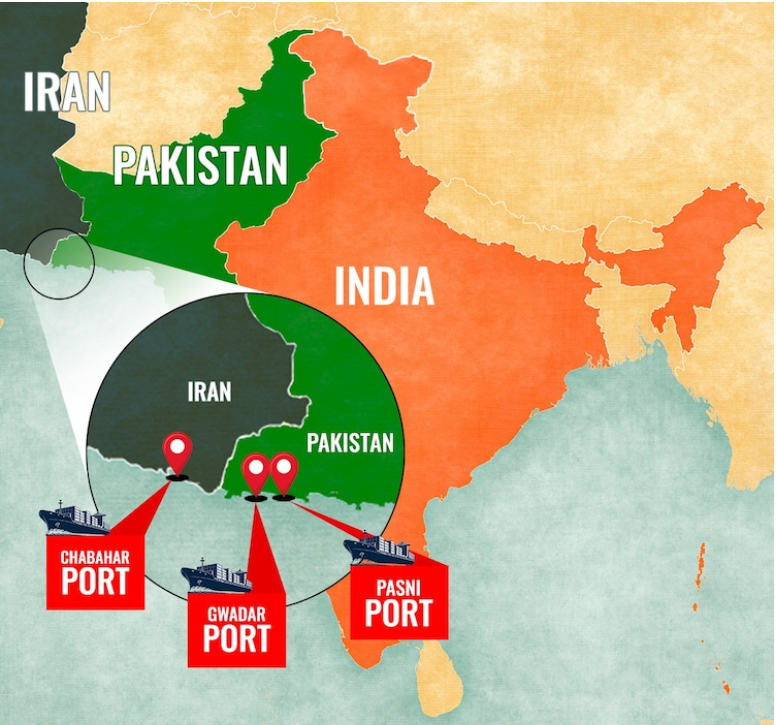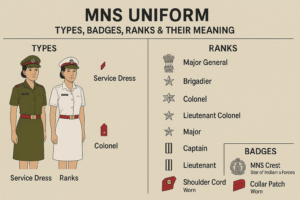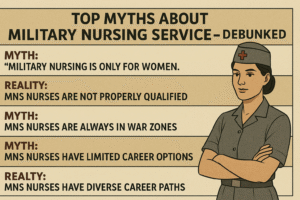🇵🇰 1. Background: Pakistan’s Offer to the US
Recently, Pakistan has reportedly offered the United States to help build and operate a port at Pasni, located near Gwadar in Balochistan.
This proposal, if accepted, could mark a major geopolitical shift in the Arabian Sea region — giving the US a potential maritime foothold near Iran and reducing Pakistan’s dependence on China’s Belt and Road Initiative (BRI).
🌊 2. Location & Geography of Pasni Port
| Feature | Details |
|---|---|
| Location | Pasni, Gwadar District, Balochistan, Pakistan |
| Coastline | Arabian Sea |
| Proximity to Key Points | – ~75 km east of Gwadar Port (China-Pakistan) – ~200 km from Chabahar Port (India-Iran) – Near the Iran–Pakistan border |
| Existing Infrastructure | Fish harbour, small deep-water facility, Pakistan Maritime Security Agency (PMSA) base |
| Proposed Development | Expansion into a modern commercial and strategic port with possible US investment |
🧭 3. Objectives Behind the Pasni Port Proposal
(a) Strategic Diversification
Pakistan aims to balance China’s influence under the China–Pakistan Economic Corridor (CPEC) by engaging the United States.
Reduces Islamabad’s overdependence on Beijing for infrastructure and financial support.
(b) Economic Interests
Attract foreign investment from Western sources, especially in port infrastructure and logistics.
Potential to develop an export hub for critical minerals and rare earths found in Balochistan.
(c) Diplomatic Recalibration
Pakistan seeks to reset relations with the US, which have cooled since the US withdrawal from Afghanistan (2021).
A port project could serve as a strategic incentive for renewed engagement.
⚓ 4. Strategic Location: The “Maritime Triangle”
Pasni Port sits at the centre of a highly strategic maritime triangle involving three key ports in the region:
| Port | Country/Partners | Strategic Role |
|---|---|---|
| Gwadar | China–Pakistan | Part of CPEC; Chinese access to Arabian Sea |
| Chabahar | India–Iran | India’s route to Afghanistan & Central Asia, bypassing Pakistan |
| Pasni (proposed) | US–Pakistan | Potential American foothold near Iran and the Strait of Hormuz |
🧩 This “Gwadar–Pasni–Chabahar” triangle could become a new geopolitical hotspot, with each port linked to a major power (China, US, India).
💰 5. Economic & Resource Dimensions
Balochistan is rich in copper, gold, and rare earth elements (REEs), crucial for semiconductors, EV batteries, and clean energy technologies.
By involving the US, Pakistan could attract Western investments in critical mineral extraction and export infrastructure.
This may also align with US efforts to secure non-Chinese sources of rare earths.
🛡️ 6. Strategic and Security Significance
(a) Maritime Access for the US
Provides Washington with strategic access to the Arabian Sea, close to Iran’s coast and the Strait of Hormuz — a critical global energy chokepoint.
Could serve as a naval logistics or intelligence facility in the region.
(b) Check on China’s Gwadar Influence
Counters China’s expanding presence at Gwadar Port, which is often viewed as part of China’s “String of Pearls” strategy encircling India.
(c) Enhanced Maritime Surveillance
US presence could bolster maritime domain awareness (MDA) in the Arabian Sea and North Indian Ocean.
Provides strategic observation over Iranian and Chinese movements.
(d) Regional Tensions
The presence of rival superpowers (US & China) in close proximity within Pakistan’s coastline could heighten geopolitical competition.
🧨 7. Implications for India
(a) Undermines India’s Chabahar Strategy
India’s Chabahar Port (Iran) was meant to bypass Pakistan for trade with Afghanistan and Central Asia.
A US-backed Pasni Port could divert strategic attention and potentially weaken Chabahar’s relevance.
The US withdrawal of Chabahar’s sanctions waiver complicates India’s involvement further.
(b) Strategic Pressure on India
India could face dual containment near its western maritime flank:
China at Gwadar
US at Pasni (if developed)
(c) Regional Connectivity Challenges
The competing port systems (Gwadar–Pasni–Chabahar) could fragment regional trade corridors instead of integrating them.
🪖 8. Implications for China
The US presence at Pasni could undermine China’s monopoly on Pakistan’s coast under CPEC.
May reduce Gwadar’s strategic exclusivity, forcing China to increase its military presence or expand cooperation with Pakistan Navy.
Could trigger US–China rivalry within a limited maritime zone — “great power proximity.”
🕊️ 9. Implications for the US
Strengthens America’s strategic visibility near the Persian Gulf without stationing forces in the Middle East.
Helps the US counter China’s Belt and Road Initiative (BRI) through infrastructure diplomacy.
Offers economic opportunities in port development, logistics, and critical mineral trade.
⚠️ 10. Challenges and Risks
Domestic Instability in Balochistan – The region faces insurgency and security risks, making foreign projects vulnerable.
China–Pakistan Friction – Gwadar is Beijing’s flagship project; Chinese opposition to a US-linked Pasni port is likely.
US–Iran Tensions – Pasni’s proximity to Iran may provoke Tehran’s concern and affect regional diplomacy.
Financial Viability – Pakistan’s economic crisis and sovereign debt issues may limit project execution.
Environmental and Social Risks – Local resistance, displacement, and ecological degradation may occur.
🌐 11. Regional and Global Impact
| Stakeholder | Likely Impact |
|---|---|
| Pakistan | Gains geopolitical leverage; diversifies alliances beyond China |
| US | Gains maritime foothold near Iran; counters China |
| China | Strategic discomfort; possible countermeasures at Gwadar |
| India | Strategic setback to Chabahar; must recalibrate Indo-Iran policy |
| Iran | Security concern due to proximity of US-linked port |
| Gulf States | Watch cautiously due to proximity to Strait of Hormuz |
🧠 12. UPSC Relevance
Prelims Focus Areas
Location of Pasni, Gwadar, and Chabahar Ports
China–Pakistan Economic Corridor (CPEC)
India–Iran Chabahar Project
String of Pearls Strategy
Critical Minerals & Rare Earths
Sample Prelims Question
Q. Consider the following pairs:
| Port | Associated Country/Partner |
|---|---|
| 1. Gwadar | China–Pakistan |
| 2. Chabahar | India–Iran |
| 3. Pasni | US–Pakistan (proposed) |
Which of the pairs given above are correctly matched?
(a) 1 and 2 only
(b) 1, 2 and 3
(c) 2 and 3 only
(d) 1 and 3 only
✅ Answer: (b)
✍️ 13. Mains Practice Question
“The emerging Pasni–Gwadar–Chabahar triangle represents a new frontier of great power rivalry in the Indian Ocean. Discuss its implications for India’s maritime and regional strategy.”
Approach:
Explain location and emerging triangle
Highlight superpower rivalry (US–China)
Discuss impacts on India’s Chabahar and regional outreach
Suggest India’s strategic options (Indo-Pacific partnerships, Iran engagement, SAGAR vision)
🔑 14. Key Takeaways for UPSC Notes
Pasni Port: Proposed US–Pakistan collaboration near Gwadar (Balochistan).
Objective: Diversify Pakistan’s foreign partnerships, attract US investment, and export critical minerals.
Strategic Triangle: Pasni (US) – Gwadar (China) – Chabahar (India).
Implications: New maritime flashpoint near Iran; challenges India’s Chabahar strategy.
Great Power Rivalry: US vs. China proximity in Pakistan’s coastline.
India’s Concern: Reduced Chabahar relevance, increased strategic pressure.
🌎 Conclusion
The Pasni Port proposal could reshape the geopolitical landscape of the North Arabian Sea, intertwining the interests of Pakistan, the US, China, Iran, and India.
If materialized, the Gwadar–Pasni–Chabahar triangle may become the next strategic hotspot of great power competition — where maritime security, energy geopolitics, and critical minerals intersect.
For India, it reinforces the need to:
Deepen Indo–Iran and Indo–Gulf cooperation,
Strengthen maritime capabilities under SAGAR, and
Sustain a balanced Indo-Pacific strategy amid shifting alliances.
Read more detailed UPSC Current Affairs and International Relations Analysis at VictorGrowth – UPSC Resources.







